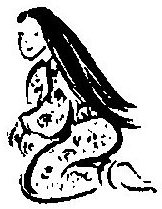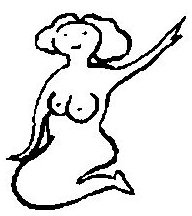|
TRANSLATIONS
If my interpretation of the (yearly solar) calendar system in Tahua is correct, we ought to find reflections of this system in other parts of the text. Earlier we met the haumea type of glyph in triplicate (Aa3-72 -- Aa4-11):
To remind ourselves I cite my thoughts then: I guess that these three lines of glyphs may be a description of the three seasons ('wives') of the year. The first two lines are qualitatively different from the last one, although all three begin with a 'priest', because there is no 'double-sun' (meaning double double-month?) in the last line. The uplifted arm of the 'priest' in the first line is similar to the 'arm' in the last glyph in the third line (connecting like alpha and omega), but different in shape from the uplifted arms of the 'priests' in the 2nd and 3rd lines. If the uplifted arm of the 'priest' in the last line is adorned with two half-circles to indicate that one year is ending and the next one beginning (during her period), then the adornments on the arms of the first two 'priests' also ought to indicate some ends and beginnings. Just for the fun of it we may imagine that these three lines of glyphs should be mapped onto the months like this:
Autumn equinox (tara) in Tarahau (March) would then be reflected in the strange deformations at the ends of rei miro (GD13):
The 'dark' October (Tangaroa Uri) may explain the po glyph (GD46) in the first line:
The asymmetry in form of the 1st wedge being marked would then mean the 1st season of the year. The two 'water' months (Vaitu Nui and Vaitu Potu) would explain the watery characteristics of:
Another interpretation of these 3 haumea lines might be that each wife of the sun had 3 subperiods consisting of 40 nights each: (121 - 1) / 3 = 40. One of the lines above would then represent 40 days, not one third of the year. I can - without much difficulty - revise my comments according to the new perspective: The polar staff (tara) at midwinter solstice would then be reflected in the strange deformations at the ends of rei miro (GD13):
The po glyph (GD46) in the first line:
depicts (as in the Taranaki storehouse) the break between old and new year. The asymmetry in form of the 3rd wedge being 'encircled' would then allude to the 'female' hole between the years. The left of the two 'water' persons:
is drawn 'double' in order to represent two of the wives (of the sun), the right one straddles the gap between old and new year, illustrated by fishy tail at left and light toes at right. In the new perspective we must make the year complete by adding more glyph sequences representing the other two wives of the sun. That is easy, we find them immediately, Aa3-16 -- 35 and Aa3-45 -- 64 (both sequences having 20 glyphs):
There are different numbers of glyphs in the 3 subdivisions, a pattern pointing at 16:
We should also tabulate the 9 appearances of the wives:
I think we should regard the en face person (bottom middle) as standing at midsummer. She (?) also has the kai gesture, indicating growing light. The haumea wife seems to be special, not only are there just 16 glyphs (instead of 20) but we also find the double 'faces' of life and death - as we may interpret the four (presumably) seasons shown in Aa1-9--12:
i.e. an uplifted arm during waxing sun and half-a-canoe for waning sun. Uplifted arm and two (different) half-a-canoe glyphs are connected with the two first lines of haumea:
Maybe it is the double-faced sun who is dying? Maybe the 4 glyphs Aa1-5-8 show four (male) arms holding up the sky roof to indicate the sky
and the 4 glyphs Aa-9--12 represent the four seasons of Mother Earth? I have reluctantly come to accept Barthel's view that haumea is female in character, but possibly the other two 'persons' are male:
Although all three in the Sycomore Lady (Nut, Isis and Hathor) are female, some male counterforce against the female dominance could later have asserted that the daylight sky (sun) must be male. Evidence point to the sun once having been female: 'From Ta'aroa and Atea, who figures in the early part of this mythological period as a female, the god Tane was born as a viable mass without form. Skilled artisans were called to shape Tane. They came in pairs, carrying their kits of stone tools slung over their shoulders, but at the sight of the majesty of Atea, they retired in fear. Then Atea herself assumed the task of shaping Tane, and successively formed all the anatomical details associated with the human body, including the boring of the external ear passages with a fine spiral shell.'' (Buck) Though number 1 still remains a male number/member we have learnt that the next largest odd number (3) is female, according to the phases/faces of the moon. Number 2 (the first even and therefore the first lucky number) we earlier understood (by reason of contrast to 1) as female (and in the easter part of the world women always walk after their men). Now another story is being told: that once sun (or rather the light wide sky - Atea) was female, i.e. both day and night were female, which (possibly) also Tahua is telling us by exhibiting one female (haumea) and two male counterparts. In The White Goddess the story of two males and one female is explained in detail: "The poet identifies himself with the God of the Waxing Year and his Muse with the Goddess; the rival is his blood-brother, his other self, his weird. All true poetry - true by Housman's practical test [i.e. it makes the hairs of one's chin bristle if one repeats it silently while shaving] - celebrates some incident or scene in this very ancient story [the Theme], and the three main characters are so much a part of our racial inheritance that they not only assert themselves in poetry but recur on occasion of emotional stress in the form of dreams, paranoic visions and delusions. The weird, or rival, often appears in nightmare as the tall, lean, dark-faced bed-side spectre, or Prince of the Air, who tries to drag the dreamer out through the window, so that he looks back and sees his body still lying rigid in bed; but he takes countless other malevolent or diabolic or serpent-like forms." "It will be objected that man has as valid a claim to divinity as woman. That is true only in a sense; he is divine not in his single person, but only in his twinhood. As Osiris, the Spirit of the Waxing Year, he is always jealous of his weird, Set, the Spirit of the Waning Year, and vice versa; he cannot be both of them at once except by an intellectual effort that destroys his humanity, and this is the fundamental defect of the Apollonian or Jehovistic cult. Man is demi-god: he always has either one foot or the other in the grave; woman is divine because she can keep both her feet always in the same place, whether in the sky, in the underworld, or on this earth. Man envies her and tells himself lies about his own completeness, and thereby makes himself miserable; because if he is divine she is not even a demi-goddess - she is a mere nymph and his love for her turns to scorn or hate. Woman worships the male infant, not the grown man: it is evidence of her deity, of man's dependence on her for life. She is passionately interested in grown men, however, because the love-hate that Osiris and Set feel for each other on her account is a tribute to her divinity. She tries to satisfy both, but can only do so by alternate murder, and man tries to regard this as evidence of her fundamental falsity, not of his own irreconsolable demands on her."
|
|||||||||||||||||||||||||||||||||||||||||||||||||||||||||||||||||||||||||||||||||||||||||||||||||||||||||||||||||||||||||||||||||||||||||||||||||||||||||||||||||











































